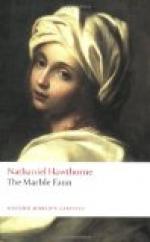This young American girl was an example of the freedom of life which it is possible for a female artist to enjoy at Rome. She dwelt in her tower, as free to descend into the corrupted atmosphere of the city beneath, as one of her companion doves to fly downward into the street;—all alone, perfectly independent, under her own sole guardianship, unless watched over by the Virgin, whose shrine she tended; doing what she liked without a suspicion or a shadow upon the snowy whiteness of her fame. The customs of artist life bestow such liberty upon the sex, which is elsewhere restricted within so much narrower limits; and it is perhaps an indication that, whenever we admit women to a wider scope of pursuits and professions, we must also remove the shackles of our present conventional rules, which would then become an insufferable restraint on either maid or wife. The system seems to work unexceptionably in Rome; and in many other cases, as in Hilda’s, purity of heart and life are allowed to assert themselves, and to be their own proof and security, to a degree unknown in the society of other cities.
Hilda, in her native land, had early shown what was pronounced by connoisseurs a decided genius for the pictorial art. Even in her schooldays—still not so very distant—she had produced sketches that were seized upon by men of taste, and hoarded as among the choicest treasures of their portfolios; scenes delicately imagined, lacking, perhaps, the reality which comes only from a close acquaintance with life, but so softly touched with feeling and fancy that you seemed to be looking at humanity with angels’ eyes. With years and experience she might be expected to attain a darker and more forcible touch, which would impart to her designs the relief they needed. Had Hilda remained in her own country, it is not improbable that she might have produced original works worthy to hang in that gallery of native art which, we hope, is destined to extend its rich length through many future centuries. An orphan, however, without near relatives, and possessed of a little property, she had found it within her possibilities to come to Italy; that central clime, whither the eyes and the heart of every artist turn, as if pictures could not be made to glow in any other atmosphere, as if statues could not assume grace and expression, save in that land of whitest marble.
Hilda’s gentle courage had brought her safely over land and sea; her mild, unflagging perseverance had made a place for her in the famous city, even like a flower that finds a chink for itself, and a little earth to grow in, on whatever ancient wall its slender roots may fasten. Here she dwelt, in her tower, possessing a friend or two in Rome, but no home companion except the flock of doves, whose cote was in a ruinous chamber contiguous to her own. They soon became as familiar with the fair-haired Saxon girl as if she were a born sister of their brood; and her customary white robe bore such an analogy to their snowy plumage that the confraternity of artists called Hilda the Dove, and recognized her aerial apartment as the Dovecote. And while the other doves flew far and wide in quest of what was good for them, Hilda likewise spread her wings, and sought such ethereal and imaginative sustenance as God ordains for creatures of her kind.




